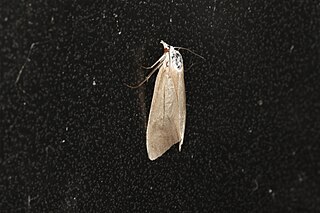
Scirpophaga is a genus of moths of the family Crambidae described by Georg Friedrich Treitschke in 1832. Asian species include significant rice stemborer pests.
Scirpophaga aurivena is a moth in the family Crambidae. It was described by George Hampson in 1903. It is found in the Khasi Hills of north-eastern India.
Scirpophaga brunnealis is a moth in the family Crambidae. It was described by George Hampson in 1919. It is found in Myanmar and Nepal.
Scirpophaga excerptalis, the white top borer or sugarcane top borer, is a moth in the family Crambidae. It was described by Francis Walker in 1863. It is found in southern Asia from the Indian Subcontinent in the west to southern China in the east, south to New Guinea, possibly Australia and the Solomon Islands.
Scirpophaga flavidorsalis is a moth in the family Crambidae. It was described by George Hampson in 1919. It is found in Yunnan, China, India, Bhutan, Bangladesh, Thailand, western Malaysia, Java, the Philippines, New Guinea and Australia.
Scirpophaga fusciflua is a moth in the family Crambidae. It was described by George Hampson in 1893. It is found in Taiwan, Afghanistan, India, Nepal, Thailand and Sri Lanka.
Scirpophaga gilviberbis is a moth in the family Crambidae. It was described by Philipp Christoph Zeller in 1863. It is found on the Comoros and in the Democratic Republic of the Congo, Kenya, South Africa, Zambia, India, Indonesia, Myanmar, Singapore, Thailand and Vietnam.
Scirpophaga gotoi is a moth in the family Crambidae. It was described by Angoon Lewvanich in 1981. It is found in the Chinese provinces of Jiangsu and Guangdong and in Japan.

Scirpophaga imparellus is a moth in the family Crambidae. It was described by Edward Meyrick in 1878. It is found in Australia, where it has been recorded from Queensland, New South Wales and Victoria.
Scirpophaga lineata is a moth in the family Crambidae. It was described by Arthur Gardiner Butler in 1879. It is found in China, Japan, India, Malaysia and Indonesia.
Scirpophaga magnella is a moth in the family Crambidae. It was described by Joseph de Joannis in 1930. It is found in China, Iran, Afghanistan, Pakistan, India, Nepal, Bangladesh, Myanmar, Thailand and Vietnam.
Scirpophaga marginepunctellus is a moth in the family Crambidae. It was described by Joseph de Joannis in 1927. It is found in Botswana, the Democratic Republic of the Congo, Madagascar, Mozambique, Nigeria, Senegal and Sudan.
Scirpophaga nivella is a moth in the family Crambidae. It was described by Johan Christian Fabricius in 1794. It is found in southern Asia from the Indian Subcontinent in the west to southern China in the east, south to New Guinea and Australia, including New Caledonia and Fiji. Some sources have affixed the common name "sugarcane top borer" to it, despite it not being found in sugarcane, because they are confused with the species Scirpophaga excerptalis, which is an actual borer in the tops of sugarcane. Another newer common name that has been invented for these moths is "white rice borer".
Scirpophaga occidentella is a moth in the family Crambidae. It was described by Francis Walker in 1863. It is found in Angola, the Democratic Republic of the Congo, Ivory Coast, Madagascar, Malawi, Mozambique, Nigeria, Senegal, Sierra Leone, South Africa and Tanzania.
Scirpophaga ochroleuca is a moth in the family Crambidae. It was described by Edward Meyrick in 1882. It is found on New Guinea and in Australia, where it has been recorded from Queensland.
Scirpophaga phaedima is a moth in the family Crambidae. It was described by Ian Francis Bell Common in 1960. It is found in northern Australia.
Scirpophaga subumbrosa is a moth in the family Crambidae. It was described by Edward Meyrick in 1933. It is found in the Democratic Republic of the Congo, Ethiopia, Ghana, Madagascar, Malawi, Mozambique, Nigeria, Senegal, Sierra Leone, Sudan, Tanzania and Zambia.
Scirpophaga virginia is a moth in the family Crambidae. It was described by Schultze in 1908. It is found in China, Taiwan, Japan, Bangladesh, Vietnam, Thailand, Sri Lanka, western Malaysia, Singapore, Borneo, Sumatra and the Philippines.
Scirpophaga xantharrenes is a moth in the family Crambidae. It was described by Ian Francis Bell Common in 1960. It is found in Australia, where it has been recorded from Queensland.
Scirpophaga xanthogastrella is a moth in the family Crambidae. It was described by Francis Walker in 1863. It is found in Taiwan, India, Nepal, Sri Lanka and the Philippines.

